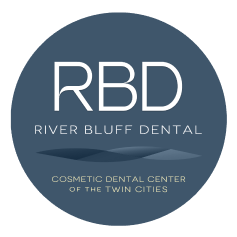Periodontics in Bloomington, MN
Prevent tooth loss with treatment for gum disease at River Bluff Dental.

Have you noticed signs of gum disease, neglected regular dental cleanings and exams, or has your brushing and flossing been subpar through the years? Progressive gum disease can lead to tooth loss. Gum disease affects millions of people, and the earlier it’s diagnosed, the less invasive and costly the treatment.
Our periodontal therapy in Bloomington, MN can safely remove bacteria that cause gum disease and treat periodontitis. If left untreated, gum disease can cause serious problems like increased risk of harmful bacteria in the bloodstream, heart disease, stroke, and diabetes.
Gum disease puts you at risk of:
Please don’t wait until it’s too late to treat gum disease.

Our dedicated team at River Bluff Dental in Bloomington, MN knows the signs and dangers of progressive periodontitis but can help you fight back with periodontal therapy.
-
Step 1
Come in for an assessment, and we’ll create your treatment plan. Each gum disease case is unique, but we typically begin with the least invasive procedure. We’ll discuss controllable factors (lifestyle) and uncontrollable (family history of disease) affecting your gum health.
-
Step 2
Scaling and root planing helps fight mild to moderate cases of periodontal disease. We clean the tooth’s root surface, remove plaque and bacteria below the gumline, and smooth the area, so it’s harder for bacteria to hold. Another non-invasive periodontal therapy includes targeted medication or antibiotics to fight the infection directly. We monitor progress and move on to the next steps if needed.
-
Step 3
Surgical options include gum grafts or bone grafts. Gum grafts protect the tooth root when there’s advanced gum recession, and bone grafts help grow new bone in place of bone loss. Gum flap surgery is another option where gums are temporarily separated from teeth to clean the affected root thoroughly. Additional options include pocket reduction surgery and dental crown lengthening.
Each case is unique, and we start with the least invasive periodontal therapy, monitor treatment, and move on to the next phase if there’s advanced periodontal disease. The worst cases of periodontal disease cause irreversible damage to the gums, roots, and teeth. In these cases, once the gum heals, a dental implant can replace the lost tooth.
-
What does periodontal treatment involve?
Periodontal treatment helps to restore the health of your gums and, in turn, your teeth. Early detection of gum disease and a periodontal therapy plan are crucial to treating periodontitis and preventing tooth loss.
Step one is to schedule a consultation with our dentist in Bloomington, MN who can properly examine your gum health.
Bacteria that stick to teeth and irritate gums lead to gum disease. We first try to control the bacteria. If the infection is treated but the tooth is damaged, we can plan to restore your smile with restorative or cosmetic dentistry.
Each case of gum disease varies on the patient, but we typically begin with the least invasive and most cost-effective procedure. The first phase is scaling and root planing, where we do a deep cleaning of the affected tooth above and below the gumline. Targeted medication may be prescribed if necessary.
Our dental team at River Bluff Dental will monitor your progress and, if needed, move on to the next phase of treatment. These treatments are more invasive, but it’s important to note that all periodontal therapy is safe and pain-free with anesthesia.
Surgical periodontal therapies include gum grafts, bone grafts, gum flap surgery, pocket reduction surgery, and dental crown lengthening. If there is tooth loss caused by gum disease, we first treat the infection, and once the gum heals, restore the tooth with a dental implant.
After periodontal therapy, preventative care is essential to maintain healthy gums. This includes brushing twice a day, flossing, maintaining biannual dental cleanings and exams, and limiting sugar intake.
-
What are three nonsurgical periodontal treatments?
The three nonsurgical periodontal treatment options include scaling and root planing to remove tartar and bacteria below the gumline, placement of medication below the gumline, and systemic antimicrobials.
Step one of periodontal treatment would be to complete scaling and root planing. After a follow-up, the dentist can determine the next step, such as a targeted medicine application.
Our goal is to use the least invasive and cost-effective treatment for your periodontal treatment. If you’re wondering which treatment is best for you, please schedule a consultation with our Bloomington, MN dentist.
-
Is periodontal therapy necessary?
Periodontal therapy is necessary to restore your oral health and prevent tooth loss when periodontal disease is present and affects your gums and bone.
Signs of periodontal disease include swollen or red gums, bleeding gums, visible pockets between gums and teeth, receding gums, bad breath, and loose teeth. Unfortunately, some signs aren’t obvious to patients, which is why it’s so important to visit your dentist regularly who can properly diagnose and monitor the health of your gums and teeth.
Untreated gum disease puts you at risk of severe health problems and disease, and irreversible tooth loss. Don’t let a preventable dental condition lead to severe complications that require extra time, money, and stress.
Step one is a diagnosis for any stage of gum disease and then a treatment plan with periodontal therapy. Patients must then maintain a healthy lifestyle and dental hygiene to keep their gums healthy. All periodontal therapies are safe and effective in helping patients get back on track to healthy gums and teeth, and in turn, their overall health.
-
Does periodontal treatment work?
Yes, periodontal treatment works and takes less time and money when periodontitis is caught early. Our dentist creates a custom treatment plan and monitors progress to help your gums and teeth heal from gum disease. After that, maintenance is important to prevent gum disease from coming back.
Periodontal treatment and therapy are most effective if patients follow instructions and maintenance post-treatment. By adequately following your dentist’s instructions, you can prevent gum disease recurrence and enjoy a happy and healthy mouth.
-
Can teeth be saved with periodontal disease?
When periodontal disease is diagnosed and treated early, nonsurgical treatments can fix the issue and prevent tooth loss.
For more serious periodontal disease, which causes bone loss and loose teeth, a specialist may have to perform surgery. If a tooth isn’t saveable, dental implant options are available; and they look and feel just like natural teeth!
Early stages of periodontal disease can most likely be treated with periodontal therapy to remove plaque and tartar at the gumline and below it to treat gum disease effectively. When bacteria get trapped below the gumline, it can wreak havoc by destroying the gum and bone tissue, in turn leading to damaged and loosened gums that lead to tooth loss.
Regular dentist visits are crucial to your health because dentists can find issues that you may not realize exist, such as gum disease. Gum disease can even be present without pain for years, but some visible signs include swollen gums, red gums, bleeding gums during brushing or flossing, loose teeth, and bad breath.
Schedule a periodontal therapy appointment in Bloomington, MN today.
